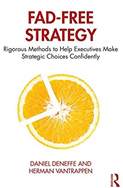Many business managers have come to see the annual planning process at their company as, at best, a necessary evil. To them, this process has become an almost perfunctory ritual that provides some sort of bottom-up foundation to prepare next year’s budget. And who could blame them for seeing it that way? There is limited value in mindlessly updating environmental trends templates or competitor profiles, or plotting enterprise risks in 2x2 grids, or extrapolating business revenues five years down the road, or undertaking any other similar chore.
While they tend to consider annual planning painful, business managers do get excited about business strategy per se: having wild dreams about disruptive innovations that will truly set the company apart from others. To be successful in such endeavors, many recent publications on strategy - blog posts, articles, books, etc. - encourage business managers to adopt one or more of the following four types of behavior:
1. Keep things simple. Just stick to some easy-to-follow rules. For instance, when under attack by low-priced players, differentiate and move upscale.
2. Learn from best-practice companies. Study the success formulas of market leaders, and simply do as they did. For example, if Netflix managed to reinvent its business model completely at least three times in the past two decades, why couldn’t you do so at least once?
3. Be agile. Don’t make detailed strategic plans, as those are pointIess in today’s VUCA (volatile, uncertain, complex and ambiguous) world. Instead, outline a vision, decide on a course of action, start implementing, and adjust as you progress.
4. Focus on execution. Don’t let a great strategy fail because of poor execution. Use change management, stakeholder communications, controlled experiments, smart performance indicators and other instruments to bridge the strategy-execution gap.
While the above four pieces of advice have merits, I find time and again that following them blindly can set you up for failure: most of the supposedly sensible rules are non-generalizable and apply only under certain conditions; today’s hero companies may not be tomorrow’s (remember, for instance, Kodak, Blackberry or Yahoo!, which at its heyday was seen by many as the example of a company that both followed simple rules and was a best-practice example for others); finally, agile and flawless execution can never make up for a possibly flawed strategy.
Those four pieces of advice are part of a way of thinking that my co-author and I, in our new book Fad-Free Strategy, are calling ‘Grand Strategy’, which we contrast with Operational Strategy. In order to explain the difference between Grand Strategy and Operational Strategy, and the extreme relevance thereof for business managers at mainstream companies, let’s go back to basics for a minute and summarize the very essence of business strategy:
Stakeholders expect a return on investment. After all, a company’s objective is to provide its stakeholders with a return on their investment (ROI). The achievement of normal financial returns creates room for the environmental, social and governance goals (ESG) that those stakeholders may want to pursue as well.
Returns are created through products. A company with a certain measure of longevity in a competitive industry creates sustainable returns if it continually brings new profitable products to market (the term “product” is used in the broad sense of “offering”, that is, it may also refer to a service, a solution, an experience, etc.). Products are the means for companies to create value, and to capture a significant part of that value. It is through the unique positioning of its products that the company enters new markets, or that it defends its current market position against new entrants, or that it maintains its customers’ loyalty, even when they care mostly about price. In other words, business strategy essentially is product strategy.
Customers are the ultimate decision-makers about the success of a company’s strategy. A company can create and capture value through its products only if customers decide to buy these products as opposed to their best alternative offering. Hence, a company’s business strategy is about making decisions that, first, are likely to influence customers to prefer the company’s product over competitive alternatives; and second, that will allow the company, if a sufficient number of customers do have such preference, to cover its costs well enough to deliver the return that its stakeholders expect. Such decisions relate to the benefits of the product (e.g., the resolution of the camera on a smartphone, the delivery time for a rush order, …) and its price.
In other words, revenues are linked to customer demand for a particular product at different price points, not to the vision and ambitions pronounced by the management team during a strategy offsite. For example, statements such as “Given the superiority of our product, we assume we will take 20% of the market” may be fine to create excitement during such an offsite but such statements are rarely solidly founded and hence may possibly give a delusive perception of what is really attainable. The success of a business strategy eventually and totally depends on the choices that customers make rather than on managers’ dreams and wishes.
Designing a top-down “vision 2025” for the company, formulating stretched ambitions (e.g., “we aim to be the recognized market leader selling 10 million cars”) and making back-of-the-envelope calculations (e.g., “taking 20% share of the five largest geographic markets, with a gross margin of 20%, …”) is part of what I call Grand Strategy. By way of contrast, rigorously eliciting customer preferences and making bottom-up evidence-based revenue and margin estimates is part of what I call Operational Strategy.
That being said, Grand Strategy is totally essential, yet its limitations must be recognized and its ambitions must be qualified accordingly: as Grand Strategy is based on averages and high-level estimates (e.g., average growth rates and profitability of a market, overall attainable market share, assumed advantages of the company, etc.), its recommendations and ambitions must be considered as hypotheses that subsequently need to be validated, adapted and detailed, or possibly even rejected, through Operational Strategy.
There is little foundation for the belief that a stretched ambition is a guarantee for success. And if business strategies fail, in many cases that is because anticipated revenues are wide off the mark, often by orders of magnitude, simply because customers are not really thrilled by any company’s specific ambition. All they care about is which company’s offering gives them the best deal, namely the difference between their willingness-to-pay and the price they have to pay.
I find that discussions about “(Grand) Strategy Design versus Strategy Implementation” are overemphasized while the real proof of the pudding is in the design of Operational Strategy - this is where actual decisions and commitments are made, and the numbers kick in, top and bottom line. Where does the overemphasis come from? Maybe it helps to think about the “I don't sell perfume, I sell hope” saying, which is varyingly attributed to Coco Chanel, Charles Revlon and Helena Rubinstein. While perfumes are expensive both to market and to buy, these grand products are supposed to make you feel and even look better.

Many strategy books suggest simplistic solutions to complicated problems. They offer rules based on anecdotal evidence pieced together from today’s hero companies and they promise top line and margin growth to executives applying those rules. But many business strategies fail, despite great execution.
Fad-Free Strategy recognizes that the choices that customers make rather than supposedly universal rules ultimately determine the success of a business strategy. It offers rigorous yet highly accessible economic tools to uncover hidden customer preferences. As a result, it helps executives to predict with confidence which strategic options will lead to commercial success. [More]
One of the reasons why Grand Strategy may be akin to perfume is that some consultants package the process well, for example by referring to the formidable achievements of hero companies. The benefits of such projects admittedly sound more exciting or comforting than those of projects that start from the hard, not-so-pleasant reality of a company struggling to enter a new market staunchly defended by incumbents, or to ward off aggressive entrants.
So, yes, Grand Strategy smells great, just like perfume. But as we do not like to admit but all know: if one doesn’t look that great, perfume, lipstick or rouge will not help - it may even make matters worse. Analogously, going for a not so solid Grand Strategy covered up by appealing ambitions that make participating managers feel good is worse than doing business as usual.
Operational Strategy, by way of contrast, is akin to medicine. If its efficacy is evidence-based and if it is properly prescribed and administered, it relieves pain, cures diseases and strengthens the body. That is the reason why companies should invest more time and resources in Operational Strategy, in spite of Coco Chanel’s insistence that "une femme sans parfum est une femme sans avenir” (“a woman without perfume is a woman without a future”). In our view, a woman (or a man, for that matter) who stays in shape without perfume can expect a better future than a scented coach potato.

